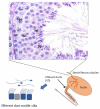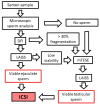Diagnostics and Management of Male Infertility in Primary Ciliary Dyskinesia
- PMID: 34573892
- PMCID: PMC8467018
- DOI: 10.3390/diagnostics11091550
Diagnostics and Management of Male Infertility in Primary Ciliary Dyskinesia
Abstract
Primary ciliary dyskinesia (PCD), a disease caused by the malfunction of motile cilia, manifests mainly with chronic recurrent respiratory infections. In men, PCD is also often associated with infertility due to immotile sperm. Since causative mutations for PCD were identified in over 50 genes, the role of these genes in sperm development should be investigated in order to understand the effect of PCD mutations on male fertility. Previous studies showed that different dynein arm heavy chains are present in respiratory cilia and sperm flagellum, which may partially explain the variable effects of mutations on airways and fertility. Furthermore, recent studies showed that male reproductive tract motile cilia may play an important part in sperm maturation and transport. In some PCD patients, extremely low sperm counts were reported, which may be due to motile cilia dysfunction in the reproductive tract rather than problems with sperm development. However, the exact roles of PCD genes in male fertility require additional studies, as do the treatment options. In this review, we discuss the diagnostic and treatment options for men with PCD based on the current knowledge.
Keywords: ICSI; PCD; male fertility; sperm.
Conflict of interest statement
The authors declare no conflict of interest.
Figures




Similar articles
-
The impact of primary ciliary dyskinesia on female and male fertility: a narrative review.Hum Reprod Update. 2023 May 2;29(3):347-367. doi: 10.1093/humupd/dmad003. Hum Reprod Update. 2023. PMID: 36721921 Free PMC article. Review.
-
CFAP300 mutation causing primary ciliary dyskinesia in Finland.Front Genet. 2022 Sep 30;13:985227. doi: 10.3389/fgene.2022.985227. eCollection 2022. Front Genet. 2022. PMID: 36246608 Free PMC article.
-
Sperm defects in primary ciliary dyskinesia and related causes of male infertility.Cell Mol Life Sci. 2020 Jun;77(11):2029-2048. doi: 10.1007/s00018-019-03389-7. Epub 2019 Nov 28. Cell Mol Life Sci. 2020. PMID: 31781811 Free PMC article. Review.
-
Primary ciliary dyskinesia and male infertility: Unraveling the genetic and clinical nexus.Andrology. 2024 Nov 21. doi: 10.1111/andr.13802. Online ahead of print. Andrology. 2024. PMID: 39572255 Review.
-
Defects in the cytoplasmic assembly of axonemal dynein arms cause morphological abnormalities and dysmotility in sperm cells leading to male infertility.PLoS Genet. 2021 Feb 26;17(2):e1009306. doi: 10.1371/journal.pgen.1009306. eCollection 2021 Feb. PLoS Genet. 2021. PMID: 33635866 Free PMC article.
Cited by
-
Meiotic divisions and round spermatid formation do not require centriole duplication in mice.PLoS Genet. 2025 Apr 28;21(4):e1011698. doi: 10.1371/journal.pgen.1011698. eCollection 2025 Apr. PLoS Genet. 2025. PMID: 40294089 Free PMC article.
-
Reproductive genetics and health.Med Genet. 2024 Sep 6;36(3):179-188. doi: 10.1515/medgen-2024-2036. eCollection 2024 Sep. Med Genet. 2024. PMID: 39257928 Free PMC article.
-
Primary ciliary dyskinesia as a rare cause of male infertility: case report and literature overview.Basic Clin Androl. 2024 Dec 18;34(1):27. doi: 10.1186/s12610-024-00244-z. Basic Clin Androl. 2024. PMID: 39695933 Free PMC article.
-
Hormonal regulation of cilia in the female reproductive tract.Curr Opin Endocr Metab Res. 2024 Mar;34:100503. doi: 10.1016/j.coemr.2024.100503. Epub 2024 Jan 6. Curr Opin Endocr Metab Res. 2024. PMID: 38293616 Free PMC article.
-
Novel HYDIN variants associated with male infertility in two Chinese families.Front Endocrinol (Lausanne). 2023 Jan 18;14:1118841. doi: 10.3389/fendo.2023.1118841. eCollection 2023. Front Endocrinol (Lausanne). 2023. PMID: 36742411 Free PMC article.
References
-
- Olbrich H., Schmidts M., Werner C., Onoufriadis A., Loges N.T., Raidt J., Banki N.F., Shoemark A., Burgoyne T., Al Turki S., et al. Recessive HYDIN mutations cause primary ciliary dyskinesia without randomization of left-right body asymmetry. Am. J. Hum. Genet. 2012;91:672–684. doi: 10.1016/j.ajhg.2012.08.016. - DOI - PMC - PubMed
Publication types
Grants and funding
LinkOut - more resources
Full Text Sources

